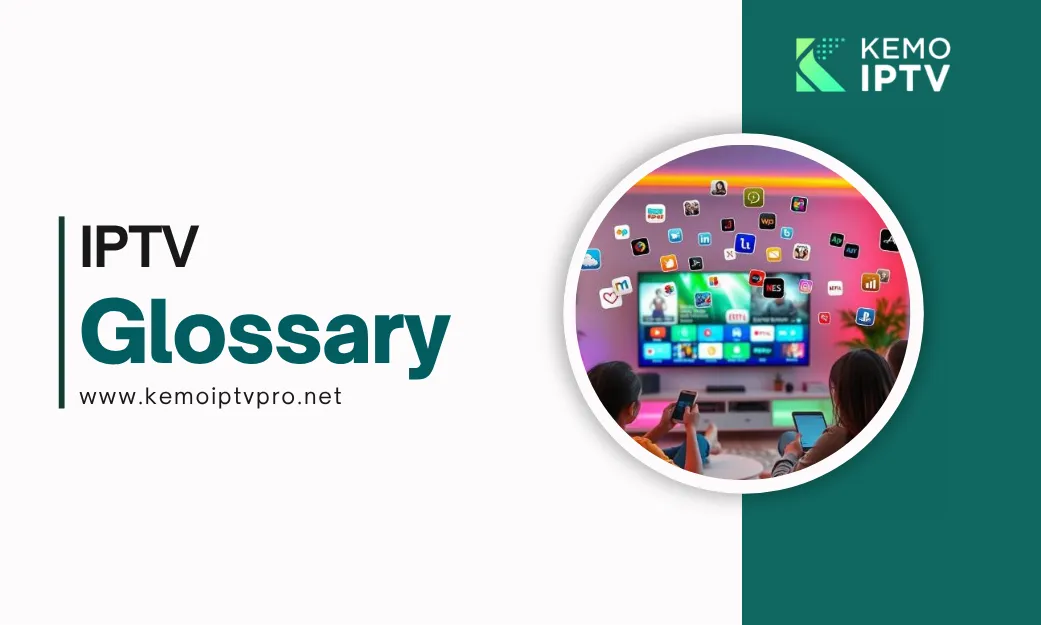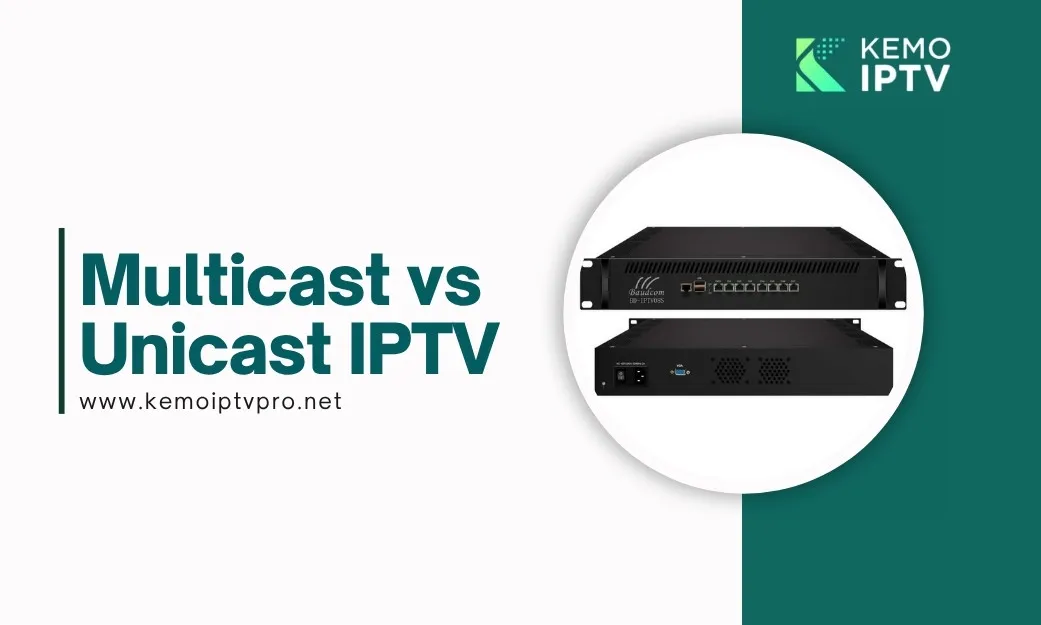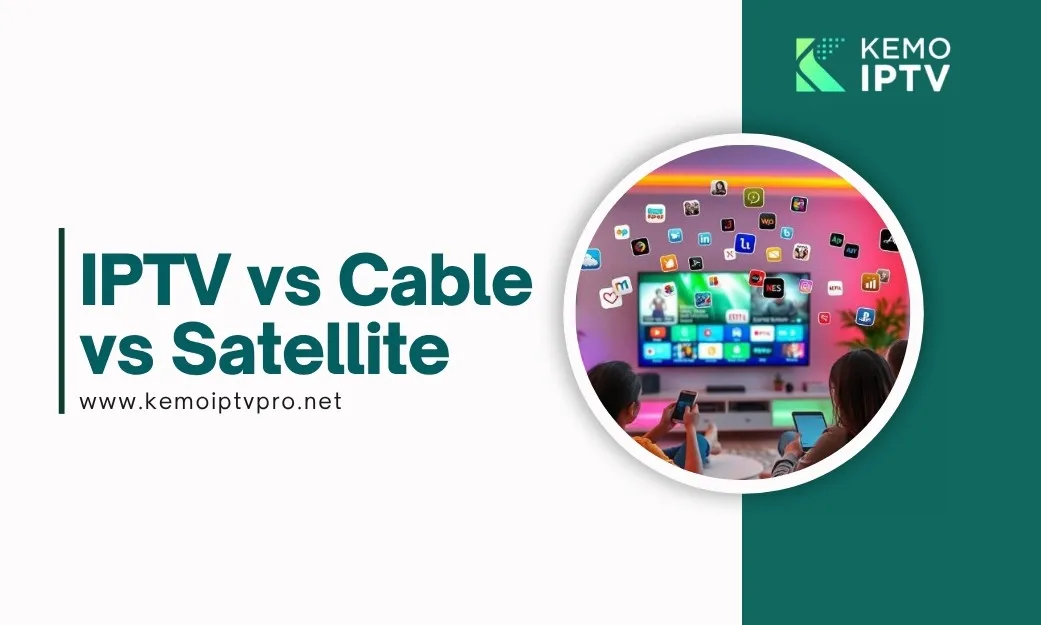The way we watch television is undergoing a massive transformation. While cable and satellite once dominated living rooms across the globe, a new challenger has emerged that’s reshaping the entire industry: IPTV (Internet Protocol Television). Today, 83% of U.S. adults use streaming services, while only 36% still maintain a cable or satellite subscription—a dramatic shift that reflects changing viewer preferences and technological capabilities.
If you’re trying to decide between IPTV, cable, and satellite TV in 2025, you’re not alone. Each technology offers distinct advantages and trade-offs in terms of cost, content, quality, and flexibility. This comprehensive guide will break down everything you need to know to make an informed decision about which service best fits your viewing habits and lifestyle.
Understanding the Basics: Cable vs. Satellite vs. IPTV
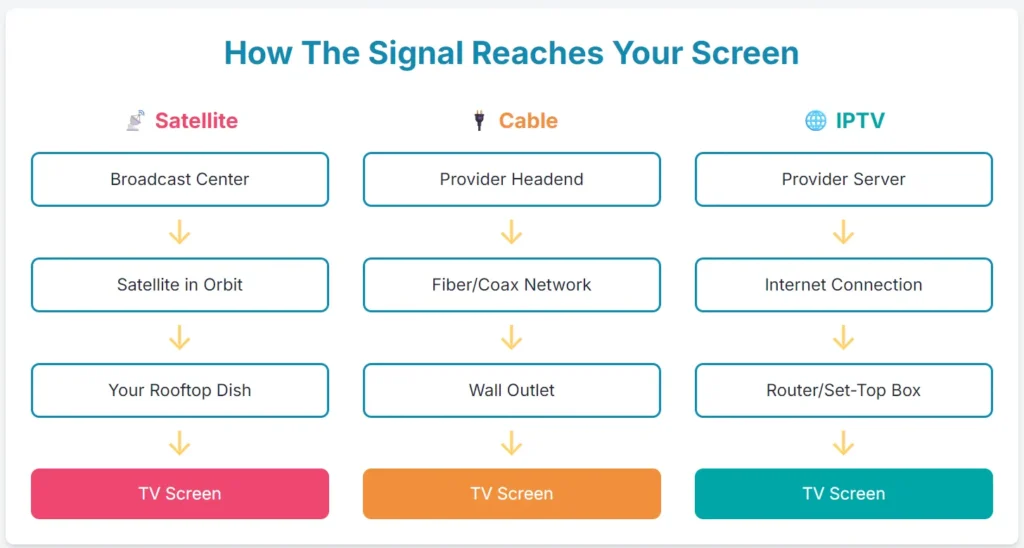
Cable Television: The Wired Veteran
Cable TV delivers programming through physical coaxial or fiber-optic cables that run directly to your home. This traditional technology has been a household staple for decades, transmitting radio frequency signals through a vast network of underground and overhead cables. Modern cable systems typically use Hybrid Fiber-Coaxial (HFC) networks, combining the high capacity of fiber optic cables for long-distance transmission with existing coaxial infrastructure for the final connection to homes.
The key characteristic of cable is its broadcast model—all available channels are transmitted to your home simultaneously on different frequencies, and your cable box simply tunes into the specific frequency of your selected channel. This “always-on” approach provides remarkable reliability but uses bandwidth less efficiently than newer technologies.
Satellite Television: Broadcasting from Space
Satellite TV takes a completely different approach, beaming signals from satellites orbiting approximately 22,000 miles above Earth directly to a dish installed at your property. These geostationary satellites appear fixed in the sky, allowing your dish to maintain a constant connection without complex tracking equipment.
The signal travels an impressive journey: programming is transmitted from ground-based uplink facilities to the satellite, which then amplifies and retransmits it back to Earth. Your satellite dish captures these signals and sends them to a receiver box that decodes them for viewing. While this wireless delivery method offers near-universal coverage, it comes with a significant vulnerability—weather interference, commonly known as “rain fade,” can disrupt service during storms or heavy cloud cover.
IPTV: Television Reinvented for the Internet Age
IPTV represents a fundamental shift in how television is delivered. Rather than using dedicated broadcast infrastructure, IPTV streams television content over the internet using the same protocols that power Netflix, YouTube, and other streaming services. However, unlike these Over-the-Top (OTT) services that use the public internet, many IPTV providers operate on managed, private networks that can guarantee specific quality levels.
The technology uses two distinct transmission methods: IP multicast for live TV, where a single stream serves multiple viewers simultaneously, and unicast for on-demand content, providing individual streams that users can pause, rewind, or fast-forward. This dual approach combines the efficiency of traditional broadcasting with the interactivity of modern streaming.
Cost and Pricing Comparison: Following the Money
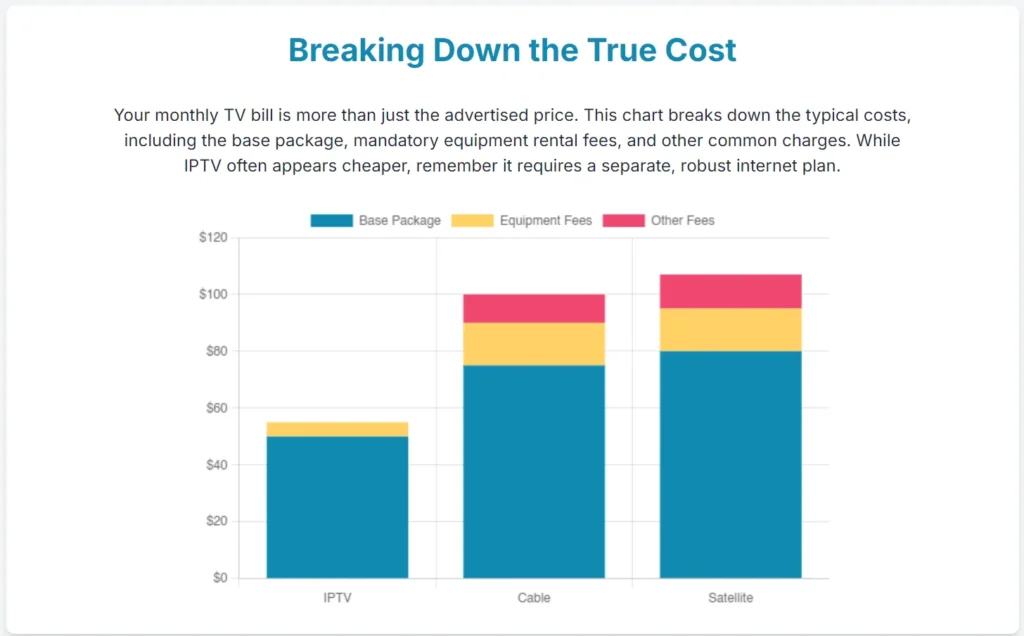
The Cable Conundrum
Cable television has earned a reputation for complex, expensive pricing. While promotional rates might start around $30-70 per month, the average U.S. cable bill reached approximately $147 per month in 2024—that’s over $1,700 annually. These costs often include hidden fees like broadcast TV surcharges, regional sports fees, and equipment rentals that can add $15-25 to your monthly bill.
Most cable providers require 1-2 year contracts, and those attractive introductory prices typically expire after 12 months, sometimes doubling your monthly cost. It’s no coincidence that over 80% of people who cancel cable cite high prices as their primary reason for cutting the cord.
Satellite’s Similar Story
Satellite TV pricing mirrors cable’s structure with promotional first-year rates starting around $85-92 per month for providers like DIRECTV and DISH. These services typically require mandatory 2-year contracts with steep early termination fees. While the first-year pricing might be guaranteed, expect a significant increase in year two. Equipment fees for additional receivers and DVR service add another $7-15 per month per device.
IPTV’s Transparent Approach
IPTV services offer refreshingly simple pricing. Plans typically range from $15-50 per month for comprehensive packages, with premium services like YouTube TV and Hulu + Live TV costing around $83 monthly. The crucial difference? No contracts, no hidden fees, and no equipment rentals in most cases. You use your own devices—smart TVs, streaming sticks, or mobile devices—eliminating those frustrating monthly box rental charges.
This transparent pricing structure means IPTV users can save hundreds or even thousands of dollars annually compared to traditional services. The ability to cancel anytime without penalties provides additional financial flexibility that cable and satellite simply can’t match.
Channel Selection and Content: Quality Over Quantity
Cable and Satellite: The Bundle Approach
Both cable and satellite excel at delivering large channel packages—often advertising “500+ channels.” However, these impressive numbers often include numerous channels you’ll never watch. Both services organize content into rigid tiers (Basic, Expanded, Premium), forcing you to purchase entire packages to access specific channels you want.
Cable’s strength lies in local content and regional sports networks (RSNs). Local franchise agreements often require cable companies to carry all local broadcast stations and comprehensive sports coverage. Satellite offers similarly broad channel lineups and has historically been strong in sports programming, with DIRECTV particularly known for comprehensive sports packages.
IPTV: Global Content at Your Fingertips
IPTV’s internet-based delivery allows for theoretically unlimited channel capacity. Services can offer vast libraries of international channels, niche networks, and specialty content that traditional providers can’t match due to spectrum limitations. Many IPTV providers include extensive on-demand libraries as part of the base package, essentially combining live TV with Netflix-style streaming.
The flexibility extends to customization—some IPTV services offer à la carte channel selection or smaller, targeted packages rather than forcing you into massive bundles. For viewers interested in international content or specific genres, IPTV often provides more relevant choices at lower prices than traditional services.
Picture Quality and Reliability: The Performance Test
Cable’s Consistency Advantage
Cable delivers rock-solid reliability through its closed, physical infrastructure. The signal quality remains consistent regardless of weather conditions or internet traffic. Most cable systems support HD content, with 4K available for select programs and events, though accessing 4K often requires specific, advanced set-top boxes.
Downtime is rare with cable, typically occurring only due to physical infrastructure damage from construction or severe weather events damaging the lines themselves. For viewers who prioritize consistency above all else, cable’s dedicated infrastructure provides peace of mind.
Satellite’s Weather Achilles’ Heel
Satellite can deliver excellent picture quality, including widespread 4K and HDR support. However, its fatal flaw is weather vulnerability. Heavy rain, snow, or even thick clouds can cause signal degradation or complete service loss—a phenomenon frustratingly familiar to satellite subscribers who’ve lost signal during crucial moments in live sports or season finales.
Beyond weather, satellite signals require perfect dish alignment and clear line-of-sight to the southern sky. Growing trees, new construction, or even strong winds that shift the dish can impact service quality.
IPTV: Quality Tied to Your Internet
IPTV’s picture quality can be exceptional—many services offer 4K resolution with HDR and Dolby Atmos audio. However, this quality is entirely dependent on your internet connection. With a robust fiber or cable internet connection providing 25+ Mbps, IPTV can deliver flawless 4K streams. But during network congestion or with inadequate bandwidth, you’ll experience buffering, resolution drops, or service interruptions.
The key advantage? IPTV isn’t affected by weather at all. As long as your internet connection remains stable, your TV service continues uninterrupted, making it more reliable than satellite in storm-prone areas.
Installation and Equipment: The Setup Experience
Traditional Services: Professional Installation Required
Cable typically requires professional installation, especially if your home isn’t already wired. Installation fees range from $40-100, and you’ll need a set-top box for each TV (at $10-15 monthly rental per box).
Satellite involves the most complex installation—mounting a dish with precise alignment to the satellite. While providers often waive installation fees for new customers, you’re still looking at receiver rental fees for each TV and potential aesthetic concerns about dish placement.
IPTV: DIY Simplicity
IPTV setup is refreshingly simple: sign up online, download an app to your smart TV or streaming device, log in, and start watching. The entire process takes minutes, not hours, with no waiting for technician appointments or drilling holes in walls. You use devices you likely already own—smart TVs, tablets, phones, or inexpensive streaming sticks—eliminating equipment rental fees entirely.
This simplicity extends to cancellation. While ending cable or satellite service involves returning equipment and potentially paying early termination fees, canceling IPTV is often as simple as clicking a button online.
Flexibility and Features: Modern Viewing Expectations
The Multi-Device Revolution
IPTV shines in flexibility. Your subscription follows you—watch on your living room TV, continue on your tablet in bed, or catch the game on your phone during your commute. One account typically supports multiple simultaneous streams across different devices. This flexibility extends globally; many IPTV services work anywhere with internet, perfect for frequent travelers.
Cable and satellite remain largely tethered to your home. While providers offer mobile apps, they often feature limited channel selections and may only work on your home network. Watching on multiple TVs requires additional set-top boxes with monthly rental fees.
Time-Shifting and On-Demand
IPTV services typically include cloud DVR with unlimited storage, automatic recording of recent programs (catch-up TV), and the ability to pause or rewind live TV—all without additional fees. Content is stored on providers’ servers, accessible from any device.
Cable and satellite rely on physical DVR boxes with limited storage capacity (typically 100-200 hours) that cost extra monthly. Recorded content is trapped on that specific box, inaccessible from other devices or locations.
Availability and Coverage: Geographic Considerations
Cable availability is limited by infrastructure. Many rural and some suburban areas simply don’t have cable lines, making it a non-option regardless of its merits.
Satellite wins the availability battle, reaching nearly 99% of U.S. households. As long as you have a clear view of the southern sky, satellite can bring hundreds of channels to the most remote locations.
IPTV availability depends entirely on internet access. With high-speed broadband, you have numerous IPTV options. But in areas with poor internet infrastructure or restrictive data caps, IPTV becomes impractical. As broadband expansion continues, particularly with 5G and fiber deployments, IPTV availability steadily improves.
The Future of Television: Writing on the Wall
The trend lines are unmistakable. Traditional pay-TV lost approximately 20 million subscribers globally between 2021 and 2023, while the IPTV market is projected to grow from $162.37 billion in 2024 to $189.25 billion in 2025—a remarkable 16.6% growth rate.
Industry leaders see the writing on the wall. Netflix co-CEO Reed Hastings predicted “the end of linear TV over the next five to 10 years,” and traditional providers are responding by launching their own streaming services and emphasizing broadband over TV services.
The future is clearly IP-based delivery. Traditional providers must evolve or risk becoming niche services for specific use cases like rural connectivity or live sports delivery.
Which Service Should You Choose?
Choose Cable If:
- You value maximum reliability and consistent quality
- You want comprehensive local channels and regional sports
- You prefer traditional channel-surfing with a simple remote
- Your internet isn’t fast enough for streaming
Choose Satellite If:
- You live in a rural area without cable or quality broadband
- You want the maximum number of channels
- You can tolerate weather-related outages
- You don’t mind 2-year contracts
Choose IPTV If:
- You want maximum flexibility and device compatibility
- Saving money is a priority
- You have reliable high-speed internet (25+ Mbps)
- You prefer on-demand and time-shifted viewing
- You want to avoid contracts and hidden fees
The Bottom Line
The television landscape has fundamentally shifted. While cable offers unmatched reliability and satellite provides universal coverage, IPTV represents the future of television delivery—offering lower costs, greater flexibility, and a modern viewing experience aligned with how people consume content today.
For most households with decent internet, IPTV provides the best combination of content, features, and value. Traditional services still serve important niches—cable for those prioritizing reliability and local sports, satellite for rural viewers—but their era of dominance has clearly passed.
The choice ultimately depends on your specific situation: your location, internet quality, viewing habits, and budget. But one thing is certain—the days of accepting expensive bundles, hidden fees, and inflexible contracts are over. Whether through IPTV or evolving traditional services, viewers now have more power than ever to customize their television experience on their own terms.


